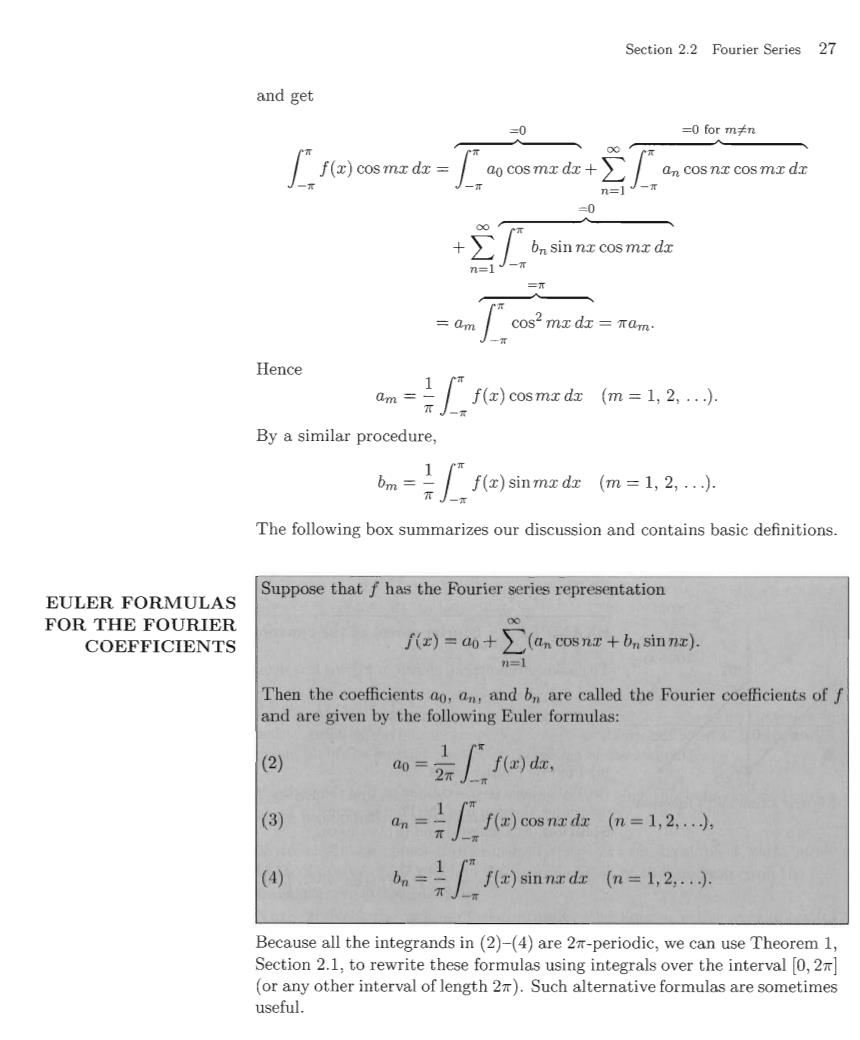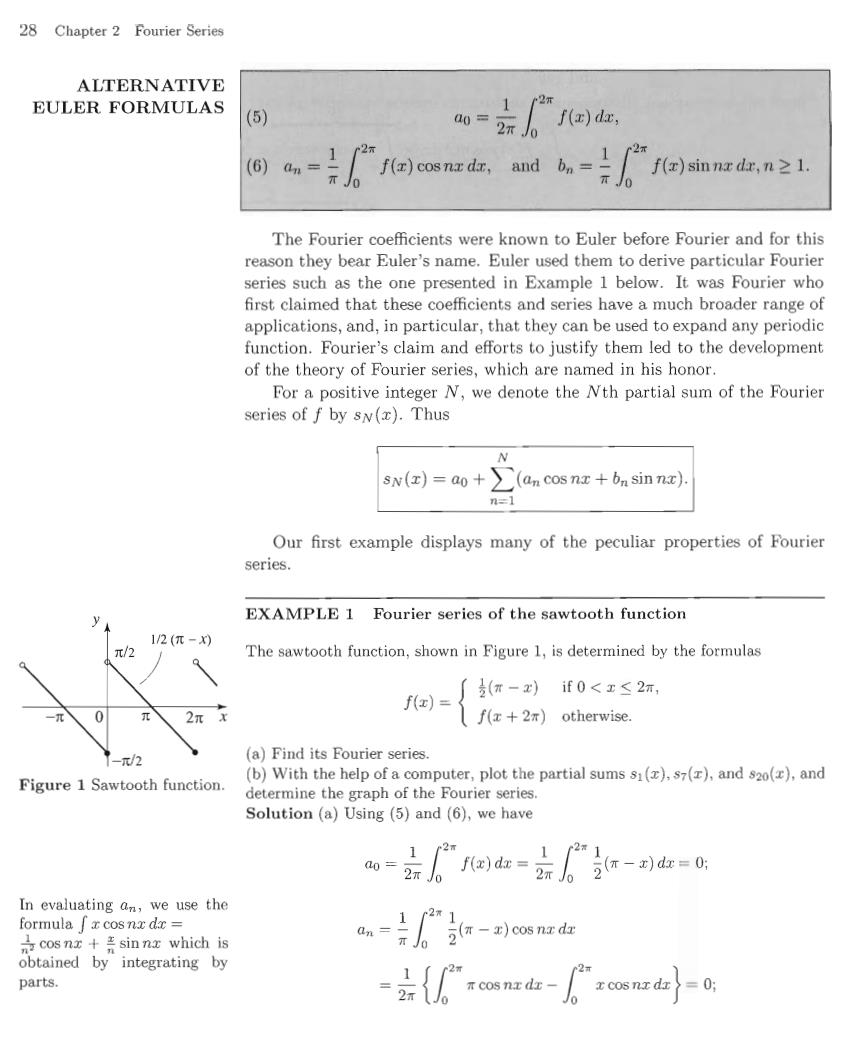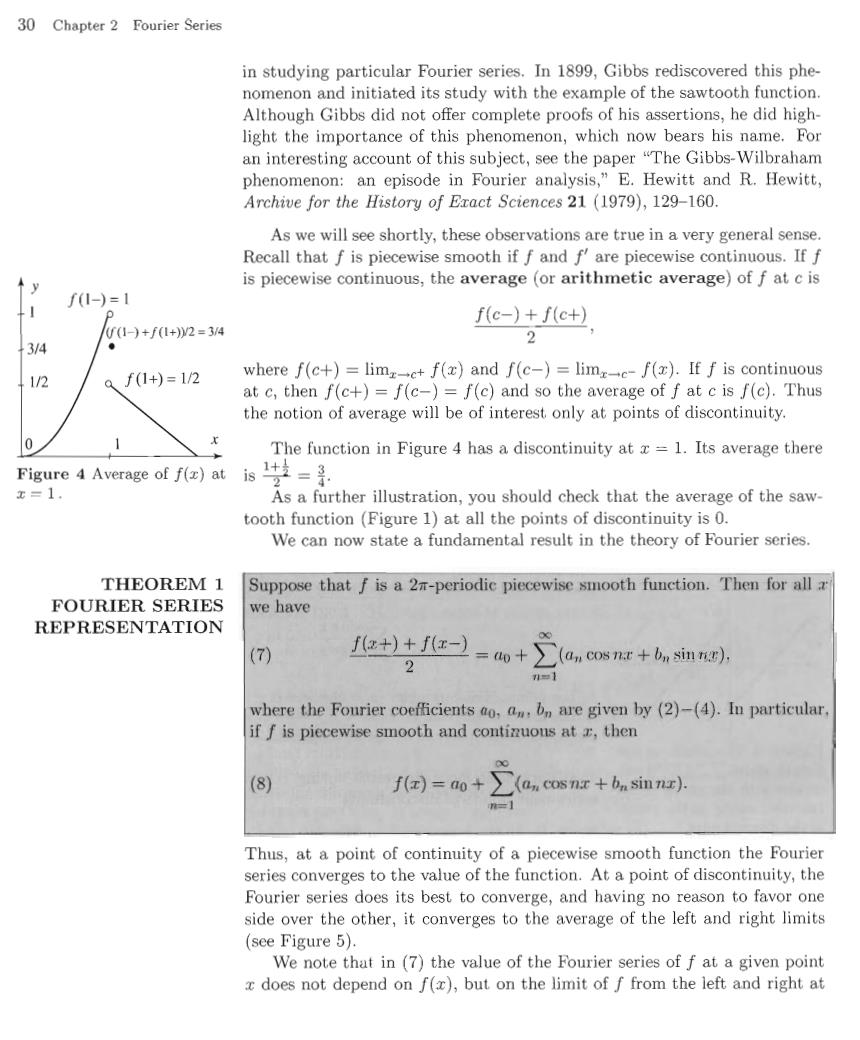
Section 2.2 Fourier Series 27 and get =0 =0form≠n ao cosma dx+ an cosnt cosmx dx n= =0 00 + bn sin nx cosmx da n=1 =am cos2 mz dx=wam. Hence f(x)cosma dz (m=1,2,...). By a similar procedure, 1 f(x)sinma dz (m=1,2,...). The following box summarizes our discussion and contains basic definitions. Suppose that f has the Fourier series representation EULER FORMULAS FOR THE FOURIER COEFFICIENTS f(z)=ao+ (an cosnr on sin nc). n=1 Then the coefficients ao,an,and bn are called the Fourier coefficients of f and are given by the following Euler formulas: (2) o=fu (3) an-fo)srd在a=1,2 (4) 6,=femm在a=l,2… Because all the integrands in(2)-(4)are 2-periodic,we can use Theorem 1, Section 2.1,to rewrite these formulas using integrals over the interval [0,2] (or any other interval of length 2).Such alternative formulas are sometimes useful

28 Chapter 2 Fourier Series ALTERNATIVE EULER FORMULAS 2元 (5) a0= 20 f(x)dx, 27 (6) an f(r)cosnz dr,and bn= f(x)sinna dr,.n≥1. The Fourier coefficients were known to Euler before Fourier and for this reason they bear Euler's name.Euler used them to derive particular Fourier series such as the one presented in Example 1 below.It was Fourier who first claimed that these coefficients and series have a much broader range of applications,and,in particular,that they can be used to expand any periodic function.Fourier's claim and efforts to justify them led to the development of the theory of Fourier series,which are named in his honor. For a positive integer N,we denote the Nth partial sum of the Fourier series of f by s(x).Thus N sN()=a0+∑ (an cos nx +bn sin n). n=1 Our first example displays many of the peculiar properties of Fourier series. EXAMPLE 1 Fourier series of the sawtooth function 1/2(π-x) π/2 The sawtooth function,shown in Figure 1,is determined by the formulas f(x)= (r-zx)if0<工≤2m, 个 2π f(x+2m) otherwise. -元/2 (a)Find its Fourier series. Figure 1 Sawtooth function. (b)With the help of a computer,plot the partial sums s1(z),s7(),and s20(),and determine the graph of the Fourier series Solution (a)Using (5)and(6),we have r2 a0= 2元J0 f(x)dx= 2元0 2r-x)d=0: In evaluating an,we use the formula「r cosnx dc= (n-x)cos na dx cos n+sin nz which is obtained by integrating by parts. { πcos nx dx x cos nx da =0

Section 2.2 Fourier Series 29 (-)sin ncdz Jo 1 7 1 2x w sin na da x sin na da 2 Jo x sinnx dx 1 -1 21n2 sinna+-cos na (integration by parts) 12=1 2x n Figure 2 Here the nth par- Substituting these values forandint(1),weobtainas the Fourier n tial sum of the Fourier series is series of f. sn()=∑t-1n卓.To dis tinguish the graphs,note that as n increases,the frequen- cies of the sine terms increase. This causes the graphs of the higher partial sums to be more wiggly.The limiting graph is the graph of the whole Fourier series,shown in Figure 3.It is identical to the graph of the function,except at points of discontinuity. (b)Figure 2 shows the first,seventh,and twentieth partial sums of the Fourier series.We see clearly that the Fourier series of f converges to f()at each point x where f is continuous.In particular,for 0<x<2,we have 元/2 sin na =2(-). n=1 2πx At the points of discontinuity(x=2kr,k=0,±l,±2,.),the series converges to π/2 0.The graph of the Fourier series is shown in Figure 3.It agrees with the graph of the function,except at the points of discontinuity. Figure 3 The graph of the Fourier series co- Two important facts are worth noting concerning the behavior of Fourier incides with the graph of the function,except at the points series near points of discontinuity. of the discontinuity. Note 1:At the points of discontinuity (x =2k)in Example 1,the Fourier series converges to 0 which is the average value of the function from the left and the right at these points. Note 2:Near the points of discontinuity,the Fourier series overshoots its limiting values.This is apparent in Figure 2,where humps form on the graphs of the partial sums near the points of discontinuity.This curious phe- nomenon,known as the Gibbs (or Wilbraham-Gibbs)phenomenon,is investigated in the exercises.It was first observed by Wilbraham in 1848

30 Chapter 2 Fourier Series in studying particular Fourier series.In 1899,Gibbs rediscovered this phe- nomenon and initiated its study with the example of the sawtooth function Although Gibbs did not offer complete proofs of his assertions,he did high- light the importance of this phenomenon,which now bears his name.For an interesting account of this subject,see the paper "The Gibbs-Wilbraham phenomenon:an episode in Fourier analysis,"E.Hewitt and R.Hewitt, Archive for the History of Exact Sciences 21 (1979),129-160. As we will see shortly,these observations are true in a very general sense. Recall that f is piecewise smooth if f and f are piecewise continuous.If f is piecewise continuous,the average(or arithmetic average)of f at c is f(1-)=1 p f(c-)+f(c+) U(1-)+f(1+)2=34 2 3/4 1/2 f(1+)=1/2 where f(c+)=limzc+f(x)and f(c-)=limz-c-f().If f is continuous at c,then f(c+)=f(c-)=f(c)and so the average of f at c is f(c).Thus the notion of average will be of interest only at points of discontinuity. The function in Figure 4 has a discontinuity at x =1.Its average there Figure4 Average off)atis+生=景. x=1, As a further illustration,you should check that the average of the saw- tooth function (Figure 1)at all the points of discontinuity is 0. We can now state a fundamental result in the theory of Fourier series. THEOREM 1 Suppose that f is a 2m-periodic piecewise smooth function.Then for all a FOURIER SERIES we have REPRESENTATION 7) )儿-=+〉 (an cos nt+on sin n.g) where the Fourier coefficients ao,abn are given by (2)-(4).In particular, if f is piecewise smooth and continuous at r,then (8) f回=0+ an cos nt+ba sinnr). Thus,at a point of continuity of a piecewise smooth function the Fourier series converges to the value of the function.At a point of discontinuity,the Fourier series does its best to converge,and having no reason to favor one side over the other,it converges to the average of the left and right limits (see Figure 5). We note that in(7)the value of the Fourier series of f at a given point x does not depend on f(x),but on the limit of f from the left and right at

Section 2.2 Fourier Series 31 x.For this reason,we may define (or redefine)f at isolated points without affecting its Fourier series.This is illustrated by the behavior of the Fourier series in Example 1,where at the points of discontinuity we could have assigned any values for the function without affecting the behavior of the Fourier series.If we redefine the function at points of discontinuity to be f(f(,we then have the equality 00 f(x)=ao+ an cos nx bn sin nx) n=l holding at all x.We will often assume such a modification at the points 0 of discontinuity and not worry about the more precise,but cumbersome, equality (7). (a)A piecewise smooth function, We will present the complete proof of Theorem 1 in Section 2.8.The proof is a nice combination of ideas from Fourier series and basic tools from calculus.Further topics related to the convergence of Fourier series are presented in Sections 2.9 and 2.10. It is important to keep in mind that continuity of f alone is not enough to ensure the convergence of its Fourier series.Although we will not encounter such functions,there are continuous functions with Fourier series that di- (b)its Fourier series. verge at an infinite number of points in [0,2m.But,as our next example illustrates,if f is continuous and piecewise smooth,then its Fourier series Figure 5 will in fact converge uniformly to f.For a proof of this fact,see Section 2.9 where we study uniform convergence in detail. EXAMPLE 2 Triangular wave The 2x-periodic triangular wave is given on the interval [-,by π+xif-T≤x≤0, g)= π-xif0≤x≤r, (a)Find its Fourier series. (b)Plot some partial sums and the Fourier series. Solution From Figure 6 we see that g(z)is piecewise smooth and continuous for 元-x all x (g'(r)does not exist at x =k).So,from the second part of Theorem 1,we expect the Fourier series to converge to g()for all x.Using(2),we have 0 2x a0= )de 2π Figure 6 Triangular wave (This is the area of the triangular region in Figure6 with base【-π,πdivided by